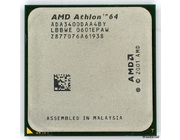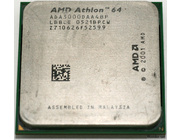Still in it's unopened box! The date-code on this CPU is 11th week of 2006 (March 2006). Back in 2003 you could buy CPU's that were faster than this particular CPU. So either no-one wanted it anymore in 2006 (not even as budget CPU...?!) or it was stored out of sight or part of a liquidation. Nevertheless: it still sits in it's original box and will be left alone for many years to come ![]() . > Read more
. > Read more
I have two of these CPU's that are very similar. They even have the same OPN (Ordering Part Number) and are both manufactured in 2006. However, this one is assembled in Malaysia whereas the other one is assembled in China.
This CPU has run 24/7 for years in a server-environment (yes, with desktop hardware...) for a certain monitoring of (mobile) temperature sensors. > Read more
This AMD Athlon 64 3000+ 'Venice' is based on the E3-stepping. Later versions came with E6-stepping as well. Differences are minimal: according to AMD's revision guide on Athlon 64's there are issues with Enhanced Write-Combining and several DDR/memory-related addressing problems with the E3-stepping that the E6 doesn't have. I'm not sure if these (noticeably) affect performance or overclockability.
The E3's are identified by Ordering Part Number (OPN) 'ADA3000DAA4BP'. I have two E6's with OPN 'ADA3000DAA4BW'. One used chip and one unused in it's original box. > Read more
An Athlon 64 with a somewhat weird Odering Part Number (OPN): almost all 3200+'s with the Venice-core have OPN ADA3200DAA4BW but this particular one has ADA3200AA4BW.
If we break the OPN down it'll be:
ADA: Athlon 64
D: 939pin OuPGA packaging
A: variable vCore
A: variable temperature
4: 512KB L2-cache.
BW: Venice DH-E6 core.
Weirdly enough this CPU doesn't have an indication of being a S939 CPU. This 3200+ Venice is basically identical except that this one does have a 'valid' OPN ![]() . > Read more
. > Read more
Identical to this one except for the location where the CPU has been assembled. Fabrication of the 'die' (core) happened in Dresden, Germany but assembling them onto a package with a heatspreader usually happens elsewhere. In this case in China. > Read more
Identical to my other AMD Athlon 64 1500+ but one year newer according to it's production date. > Read more
Released in november 2005 as low-power (9W TDP) Athlon 64 CPU. It doesn't have the IHS (Integrated Heat Spreader) to make the physical dimensions smaller and lighter and to help increase heat dissipation.
As far as I know this CPU was not sold in boxed versions through regular OEM-channels. The CPU ended up in blade systems like HP BladeSystem bc1500.
Theoretically it can be run in regular S754 motherboards but I haven't tested that yet. > Read more
This is the later BH-E6 stepping of the Venice-core. Otherwise it's practically identical to this E3 3000+ CPU. A slight difference can be seen on the packaging: this one is assembled in China, the other in Malaysia. > Read more
Just like this Athlon 64 3500+ but with a different production date.
Both have the Venice E6 core. As time passed by (since the first Athlon 64 / Opteron engineering sample) AMD was tuning the existing cores to make small improvements (better on-die memory controller, scalability, bugfixes, etc.) which means there are many different CPU's that carry the number '3500+' You can find the 3500+ on S939 with Clawhammer CG, Newcastle CG, Winchester D0, San Diege E4, Venice E3 and E6 and Manchester E4. The latter is actually a dual-core chip but with one core disabled so effectively it's a single-core ![]() .
.
Disabling parts on a chip is something that happens quite often. The performance products have more cores, L2-cache or something similar. In case one core or a part of the L2-cache is defective the chip has to be rejected. To avoid this chip manufacturers (not only AMD but also ATi, NVIDIA and Intel for example) disable parts of the chip and sell it for a lower price. > Read more
The 3500+ was a good performing product for quite a while. The first 3500+ with Clawhammer core (130nm) was announced half-way 2004. The first Venice (90nm) core was introduced in April 2005 and this CPU was made in the 46th week of 2005. Quite a bit later and the first dual-core processors were around by then. > Read more











